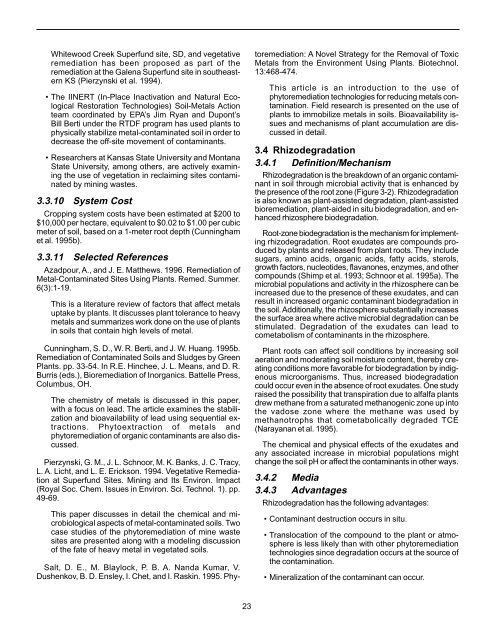Introduction to Phytoremediation - CLU-IN
Introduction to Phytoremediation - CLU-IN
Introduction to Phytoremediation - CLU-IN
Create successful ePaper yourself
Turn your PDF publications into a flip-book with our unique Google optimized e-Paper software.
Whitewood Creek Superfund site, SD, and vegetative<br />
remediation has been proposed as part of the<br />
remediation at the Galena Superfund site in southeastern<br />
KS (Pierzynski et al. 1994).<br />
• The I<strong>IN</strong>ERT (In-Place Inactivation and Natural Ecological<br />
Res<strong>to</strong>ration Technologies) Soil-Metals Action<br />
team coordinated by EPA’s Jim Ryan and Dupont’s<br />
Bill Berti under the RTDF program has used plants <strong>to</strong><br />
physically stabilize metal-contaminated soil in order <strong>to</strong><br />
decrease the off-site movement of contaminants.<br />
• Researchers at Kansas State University and Montana<br />
State University, among others, are actively examining<br />
the use of vegetation in reclaiming sites contaminated<br />
by mining wastes.<br />
3.3.10 System Cost<br />
Cropping system costs have been estimated at $200 <strong>to</strong><br />
$10,000 per hectare, equivalent <strong>to</strong> $0.02 <strong>to</strong> $1.00 per cubic<br />
meter of soil, based on a 1-meter root depth (Cunningham<br />
et al. 1995b).<br />
3.3.11 Selected References<br />
Azadpour, A., and J. E. Matthews. 1996. Remediation of<br />
Metal-Contaminated Sites Using Plants. Remed. Summer.<br />
6(3):1-19.<br />
This is a literature review of fac<strong>to</strong>rs that affect metals<br />
uptake by plants. It discusses plant <strong>to</strong>lerance <strong>to</strong> heavy<br />
metals and summarizes work done on the use of plants<br />
in soils that contain high levels of metal.<br />
Cunningham, S. D., W. R. Berti, and J. W. Huang. 1995b.<br />
Remediation of Contaminated Soils and Sludges by Green<br />
Plants. pp. 33-54. In R.E. Hinchee, J. L. Means, and D. R.<br />
Burris (eds.), Bioremediation of Inorganics. Battelle Press,<br />
Columbus, OH.<br />
The chemistry of metals is discussed in this paper,<br />
with a focus on lead. The article examines the stabilization<br />
and bioavailability of lead using sequential extractions.<br />
Phy<strong>to</strong>extraction of metals and<br />
phy<strong>to</strong>remediation of organic contaminants are also discussed.<br />
Pierzynski, G. M., J. L. Schnoor, M. K. Banks, J. C. Tracy,<br />
L. A. Licht, and L. E. Erickson. 1994. Vegetative Remediation<br />
at Superfund Sites. Mining and Its Environ. Impact<br />
(Royal Soc. Chem. Issues in Environ. Sci. Technol. 1). pp.<br />
49-69.<br />
This paper discusses in detail the chemical and microbiological<br />
aspects of metal-contaminated soils. Two<br />
case studies of the phy<strong>to</strong>remediation of mine waste<br />
sites are presented along with a modeling discussion<br />
of the fate of heavy metal in vegetated soils.<br />
Salt, D. E., M. Blaylock, P. B. A. Nanda Kumar, V.<br />
Dushenkov, B. D. Ensley, I. Chet, and I. Raskin. 1995. Phy-<br />
23<br />
<strong>to</strong>remediation: A Novel Strategy for the Removal of Toxic<br />
Metals from the Environment Using Plants. Biotechnol.<br />
13:468-474.<br />
This article is an introduction <strong>to</strong> the use of<br />
phy<strong>to</strong>remediation technologies for reducing metals contamination.<br />
Field research is presented on the use of<br />
plants <strong>to</strong> immobilize metals in soils. Bioavailability issues<br />
and mechanisms of plant accumulation are discussed<br />
in detail.<br />
3.4 Rhizodegradation<br />
3.4.1 Definition/Mechanism<br />
Rhizodegradation is the breakdown of an organic contaminant<br />
in soil through microbial activity that is enhanced by<br />
the presence of the root zone (Figure 3-2). Rhizodegradation<br />
is also known as plant-assisted degradation, plant-assisted<br />
bioremediation, plant-aided in situ biodegradation, and enhanced<br />
rhizosphere biodegradation.<br />
Root-zone biodegradation is the mechanism for implementing<br />
rhizodegradation. Root exudates are compounds produced<br />
by plants and released from plant roots. They include<br />
sugars, amino acids, organic acids, fatty acids, sterols,<br />
growth fac<strong>to</strong>rs, nucleotides, flavanones, enzymes, and other<br />
compounds (Shimp et al. 1993; Schnoor et al. 1995a). The<br />
microbial populations and activity in the rhizosphere can be<br />
increased due <strong>to</strong> the presence of these exudates, and can<br />
result in increased organic contaminant biodegradation in<br />
the soil. Additionally, the rhizosphere substantially increases<br />
the surface area where active microbial degradation can be<br />
stimulated. Degradation of the exudates can lead <strong>to</strong><br />
cometabolism of contaminants in the rhizosphere.<br />
Plant roots can affect soil conditions by increasing soil<br />
aeration and moderating soil moisture content, thereby creating<br />
conditions more favorable for biodegradation by indigenous<br />
microorganisms. Thus, increased biodegradation<br />
could occur even in the absence of root exudates. One study<br />
raised the possibility that transpiration due <strong>to</strong> alfalfa plants<br />
drew methane from a saturated methanogenic zone up in<strong>to</strong><br />
the vadose zone where the methane was used by<br />
methanotrophs that cometabolically degraded TCE<br />
(Narayanan et al. 1995).<br />
The chemical and physical effects of the exudates and<br />
any associated increase in microbial populations might<br />
change the soil pH or affect the contaminants in other ways.<br />
3.4.2 Media<br />
3.4.3 Advantages<br />
Rhizodegradation has the following advantages:<br />
• Contaminant destruction occurs in situ.<br />
• Translocation of the compound <strong>to</strong> the plant or atmosphere<br />
is less likely than with other phy<strong>to</strong>remediation<br />
technologies since degradation occurs at the source of<br />
the contamination.<br />
• Mineralization of the contaminant can occur.
















